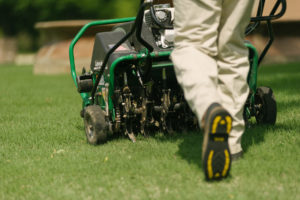
Grading and Seeding
Grading and seeding is an intensive lawn seeding method. It is performed using excavation equipment that pushes around the existing soil to create the proper grade. Once the new grade is established, grass seed is spread over the surface with a coating of straw or erosion matting. If you have an existing lawn, chances are this method is going to be the most costly and not necessarily the best lawn seeding method for your lawn.
Sodding
Sodding is the terminology used when sod, a section of grass-covered surface is held together with matted roots is installed on a soil surface. The sod is grown on a sod farm for 9 months or more. As the result, you get an immediate lawn. Of course, it is 10 times the cost of seeding. Sod requires lots of watering and care to keep it alive. Sodding may be an option if you are challenged to establish seed in your yard immediately but typically the best method is seeding for the average lawn.
Slice Seeding
You may have heard of slice seeding, sometimes referred to as “slit seeding,” as a possible method for seeding your lawn. The process utilizes a piece of machinery called a slice seeder to make ½ inch to 1-inch deep slices in the ground with its vertical blades. Grass seed is then dropped into these slices. Slice seeding is one of the most intense lawn seeding methods for established lawns and overkill for a lawn that is in half-decent shape. A slice seeder will rip out existing plants and till up a lot of your existing healthy lawn. Typically this method is best used if you need a complete renovation of your lawn.
Hydroseeding
Hydroseeding is a planting process that uses a combination of seed and mulch. It is often used as an erosion control technique on construction sites, as an alternative to the traditional process of broadcasting or sowing dry seed. This method is ineffective if nothing is done to improve the soil quality so that grass can establish healthy roots. If you have clay soil and hydroseed, you are just throwing grass seed on top of rock hard ground and it is not going to take root.
Overseeding
Overseeding is spreading grass seed over an existing lawn. Done right, it’s a straightforward process that gets results. The process of overseeding by itself is not going to be very effective. Before seeding, you must loosen the soil so that roots can develop easily. Seeds must have contact with loosened soil to be able to grow.
Aeration and Overseeding
Spring is not the ideal time to aerate the lawn, but circumstances may require it. If the soil is so compacted that existing grass can’t grow, it may be necessary to aerate in the spring. Generally, though, spring aerating is discouraged because the aeration holes provide a perfect spot for weed seeds to germinate. During aeration, a machine called a core aerator is used to pull half-inch diameter cores of soil, about two inches deep, throughout the lawn. New grass will grow out of the created holes as well as on the cores that are pulled and let atop the lawn. It is an ideal condition for growing new grass plants. Best done in the Fall.
The Bottom Line
The most cost-effective method is aeration and overseeding and it is the most effective method for seeding an existing law. Sod is the most expensive as much as $1.00 per square foot but it is the quickest way to get a new lawn. Slice seeding is twice the cost of aeration and seeding and six times the cost of just seeding, rarely does a lawn need such intense service. Aeration and overseeding works for the majority of lawns. The process introduces new grass and helps an established lawn as well. Many homeowners make aeration and overseeding part of their annual lawn care plans. By choosing aeration and overseeding you will end up with a healthy lawn that has long-lasting results. Put this tip to practice for a lush lawn!
Green & Grow Can Help!
- Lawn & Soil Aeration – Lawn aeration will help strengthen the roots and allow the grass to grow deeper. Strong roots in grass will help make it look very green and more beautiful. Our aeration specialists are trained in the latest aeration technologies. We have the expertise to design, troubleshoot, repair and effectively maintain any type of system.
- Lawn Power Seeding – A dense lawn is the best natural defense against weed and insect damage. As your lawn ages, individual grass plants weaken, which can result in a thin, unhealthy lawn. Our power seeder’s reciprocating action prepares the seed bed for maximum seed germination without damaging the existing turf and also provides a light dethatching. This process includes ground-metered distribution and delivers exactly the right amount of seed to encourage plant development and lawn aeration.
Contact us (859-314-LAWN) for more information or a free instant quote!
—
 About Green & Grow
About Green & Grow
Green & Grow is a full service lawn care company specializing in lawn mowing, fertilization & weed control, aeration & seeding, insect control, and more!
> Learn More


 About Green & Grow
About Green & Grow